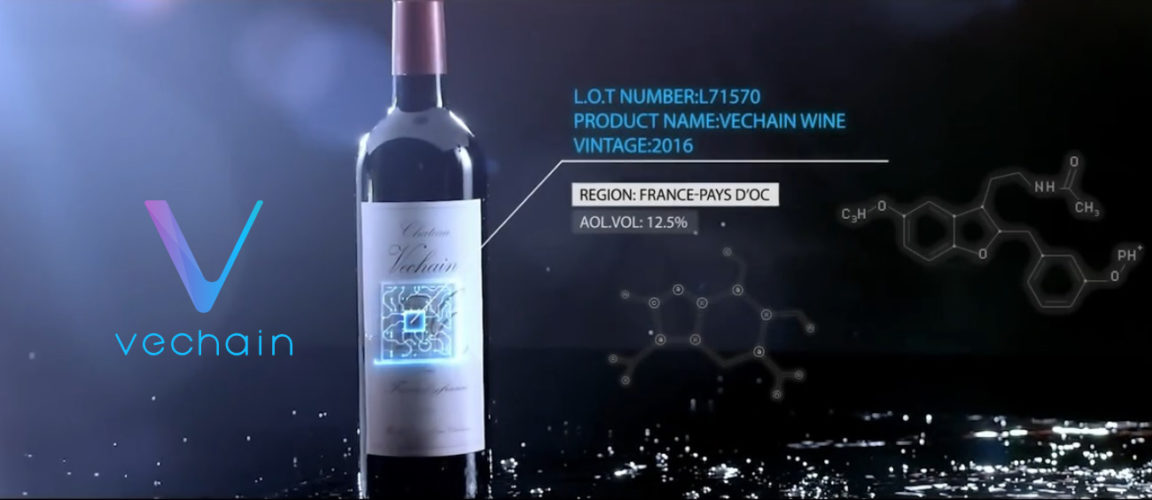Fake products are a rising concern in the modern marketplace. According to NetNames (2014), a leading online brand protection company, the global cost of counterfeiting was around 1.8 trillion dollars in 2014, seeing a huge rise every year. [1]
Initiatives, build on Blockchain technology, try to fight counterfeit. VeChain, a Chinese enterprise blockchain startup, as well as a major cryptocurrency, will be discussed in this blog. VeChain focusses on the wine industry, a major industry in China that struggles with fake wine. VeChain is not alone, as China’s national government also tries to fight this problem. Their strategic objective with regard to counterfeit: “to complete product traceability system by 2020”. [2]
Now how does this work? To understand this, you probably want to get to know more about the Blockchain Technology. “A blockchain is a decentralized, distributed and public digital ledger that is used to record transactions across many computers so that the record cannot be altered retroactively without the alteration of all subsequent blocks and the consensus of the network”. [3]
Let’s point out some key points of this definition. First of all, Blockchain Technology makes information systems more transparent. Every transaction that is made on the blockchain will be displayed in the system and will be available for everyone to see. Second of all, every individual transaction is uniquely time-stamped. This means that every transaction includes some information about the previous transaction. In this way, all transaction (or blocks) are connected (chained) to each other (now you also know why it is called Block-Chain). This makes it impossible to tamper a single transaction, as you then have to tamper every transaction in the blockchain. [4]
Now you know somewhat more about the technology, let’s get back to VeChain. Let’s say that you are a wine lover that is willing to pay more than a 1000 dollars for a bottle of wine. Your favourite wine is one from a very specific region in Italy, and you want to be very sure that the wine bottle you are buying online or in a store is actually from that region. As of now, you have to trust the producer or intermediary. However, as mentioned in the introduction, there are not too many reasons to trust these persons, as fake wine and counterfeit are becoming more existent in the current market space.
Through Blockchain Technology, VeChain provides a solution. If you buy a bottle of wine that uses Blockchain Technology, you can simply scan the QR-code on the bottle, and you can see all product specifications of that specific bottle. You can see the region where the grapes are picked, where it is manufactured, etcetera. Because it saved is on the blockchain, you can be sure that this information has not been tampered, and be assured that the bottle you just bought is actually from that Italian region you like.
Want to know more about Blockchain Technology, use-cases, or cryptocurrencies? Do not hesitate to contact me or respond to this blog! 🙂
Sources:
[1]
NetNames 2014
https://industrytoday.com/article/global-cost-of-counterfeiting-is-1-8-trillion1-according-to-new-netnames-report/
[2]
VeChain Foundation, 2017
View at Medium.com
[3]
Siraj Raval 2016
https://books.google.nl/books?id=fvywDAAAQBAJ&pg=PA1&redir_esc=y#v=onepage&q&f=false
[4]
IBM 2018
https://www-01.ibm.com/common/ssi/cgi-bin/ssialias?htmlfid=24012424USEN


Hi Vincent,
Thank you for this interesting blog. I like how you explained blockchain technology and linked this to your specific case. However the opportunities of blockchain seem to offer huge opportunities in transparency, I am doubting about its viability.
For example in the wine industry, you have the labels “Grand Cru” and “Cru”. Grand Cru is considered as one of the finest wines in France. Price differences between Grand Cru and Cru wines can sometimes be more than a thousand euros, whereas the difference in vineyard location is sometimes not more than 500 metres.
My question: How can a buyer of a Grand Cru wine be assured that the grapes are actually coming from that Grand Cru vineyard? And not his neighbour’s vineyard? I understand that you can but a QR-code on a bottle of wine, but how can you track every single grape in a specific vineyard?
Still think this is a really interesting project. Had a quick look at your second source, and saw that they also try to incorporate this technology in luxury goods (e.g. to fight counterfeited Gucci shirts). Think it has a huge potential! Thanks for sharing!